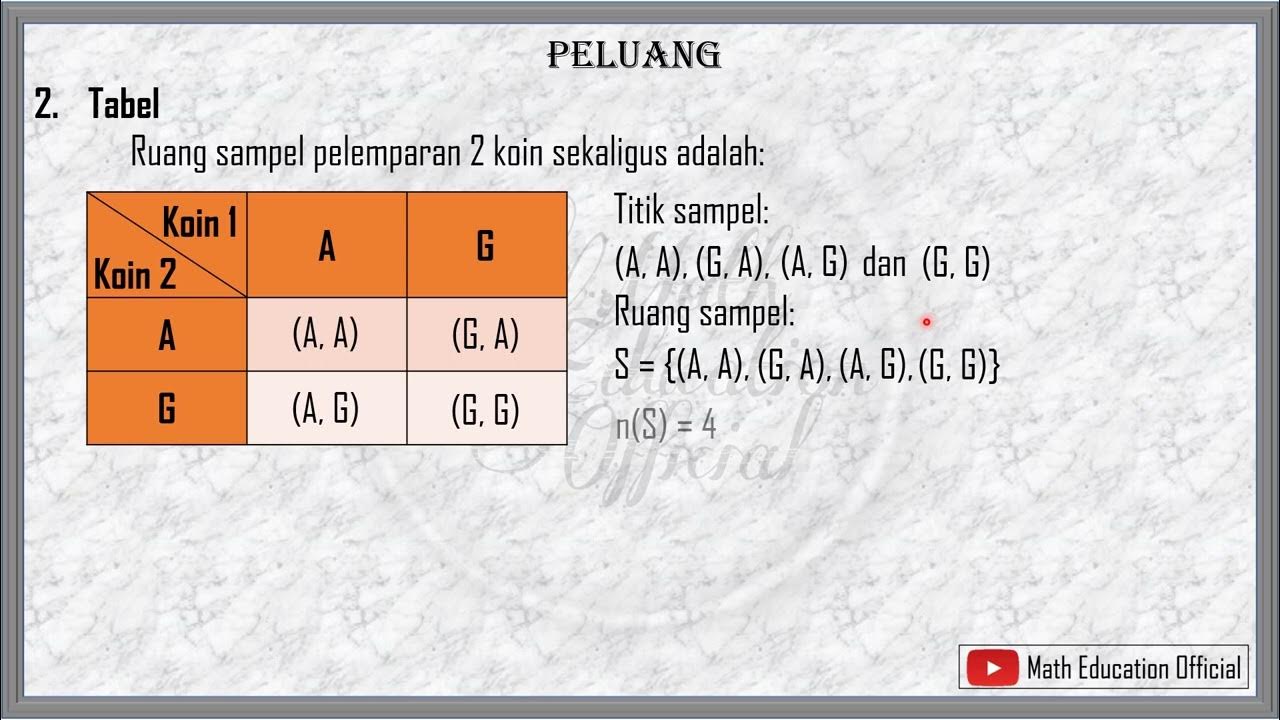Math Antics - Basic Probability
Summary
TLDRThis Math Antics video introduces the concept of probability, explaining how to deal with uncertain events like coin tosses and dice rolls. It illustrates the use of a Probability Line, ranging from 0 (impossible) to 1 (certain), to understand likelihoods. The video demonstrates how to calculate probabilities for various scenarios, including spinning a wheel with different sectors and drawing marbles from a bag, emphasizing that the sum of all possible outcomes equals 1. It highlights the importance of conducting multiple trials for results to reflect expected probabilities and encourages practice to master the concept.
Takeaways
- 🧩 Probability deals with the likelihood of events that are not always certain, like tossing a coin or rolling a die.
- 🎯 In a fair coin toss, the probability of getting heads or tails is equal, each being one-half or 50%.
- 📏 The Probability Line ranges from 0 (impossible) to 1 (certain), representing the likelihood of an event occurring.
- 🎲 When rolling a standard six-sided die, the probability of rolling any specific number is one-sixth or approximately 16.7%.
- 🔢 Probabilities can be expressed as fractions, decimals, or percentages, all of which are interchangeable.
- 📉 An event with a probability less than one-half is considered unlikely, while one greater than one-half is likely.
- 🔮 Conducting multiple trials of a random event can help approximate the expected probabilities over time.
- 🧩 The sum of the probabilities of all possible outcomes of a single trial must equal 1, as one outcome is certain to occur.
- 🌈 When using a spinner with multiple sectors, the probability of landing on a specific sector is the number of that sector divided by the total number of sectors.
- 💎 In a bag of marbles with different colors, the probability of drawing a marble of a certain color is the number of that color divided by the total number of marbles.
- 📚 Understanding basic probability involves calculating the ratio of favorable outcomes to the total number of possible outcomes and recognizing the limits of the Probability Line.
Q & A
What is probability?
-Probability is a value that tells us how likely an event is to happen.
How is probability different from certainty in math?
-In math, certainty involves things that always happen the same way, like 1 + 1 = 2. Probability deals with events that might happen but are not guaranteed, like a coin toss.
What does a probability of 0 mean?
-A probability of 0 means that an event cannot happen; it is impossible.
What does a probability of 1 mean?
-A probability of 1 means that an event is definitely going to happen; it is certain.
How is probability represented on a number line?
-Probability is represented on a number line that goes from 0 to 1, where 0 is impossible, 1 is certain, and values in between represent varying degrees of likelihood.
What is the probability of getting heads or tails in a fair coin toss?
-The probability of getting heads or tails in a fair coin toss is 1/2 or 0.5 or 50%.
How do you calculate the probability of rolling a specific number on a standard die?
-The probability of rolling a specific number on a standard six-sided die is 1/6, which is about 0.167 or 16.7%.
Why might the results of a few trials differ from the expected probabilities?
-The results of a few trials might differ from the expected probabilities because random events can vary in the short term. More trials tend to produce results closer to the expected probabilities.
How can probabilities be expressed other than fractions?
-Probabilities can also be expressed as decimals or percentages. For example, 1/2 can be written as 0.5 or 50%.
What happens when you add up the probabilities of all possible outcomes of a trial?
-When you add up the probabilities of all possible outcomes of a trial, the total is always 1 or 100%, because it is certain that one of the possible outcomes will happen.
Outlines

This section is available to paid users only. Please upgrade to access this part.
Upgrade NowMindmap

This section is available to paid users only. Please upgrade to access this part.
Upgrade NowKeywords

This section is available to paid users only. Please upgrade to access this part.
Upgrade NowHighlights

This section is available to paid users only. Please upgrade to access this part.
Upgrade NowTranscripts

This section is available to paid users only. Please upgrade to access this part.
Upgrade NowBrowse More Related Video

Probability Concepts for Data Analysis and Data Science | Statistics for Data Science

Mengenal Ruang Sampel, Titik Sampel dan Kejadian

Peluang [Part 1] - Ruang Sampel dan Titik Sampel

Peluang Matematika Kelas 8 SMP

PELUANG: MATEMATIKA KELAS 8 SMP

Peluang | Matematika Kelas X SMA/SMK FASE E | Materi dan Latihan Soal
5.0 / 5 (0 votes)